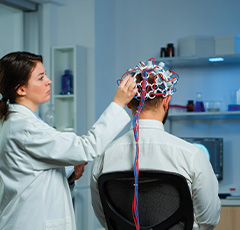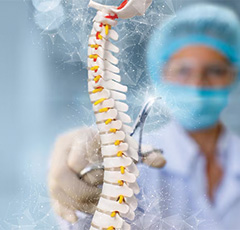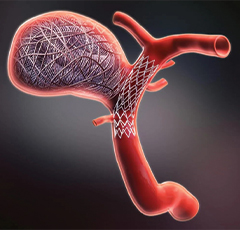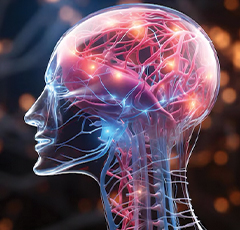Overview
The Neurosurgery Department specializes in the diagnosis, treatment, and surgical management of disorders affecting the brain, spine, and peripheral nerves. Our team of highly skilled neurosurgeons employs the latest technology and minimally invasive techniques to provide comprehensive care for conditions such as brain tumors, spinal disorders, and cerebrovascular diseases. We prioritize patient safety and recovery, ensuring personalized treatment plans that address the unique needs of each patient. With a commitment to excellence, our goal is to improve neurological health and enhance the quality of life for our patients.
TREATMENTS & PROCEDURE

Advanced techniques for the surgical removal of benign and malignant brain tumors.
Brain tumor surgery involves the precise removal of tumors using advanced imaging and minimally invasive techniques to minimize damage to surrounding tissues and improve patient outcomes.

Surgical procedure to join two or more vertebrae to alleviate pain and restore stability.
Spinal fusion involves connecting vertebrae in the spine using bone grafts or metal devices to treat conditions like degenerative disc disease, scoliosis, and spinal fractures, providing pain relief and stability.

Procedures to treat brain aneurysms and prevent hemorrhagic strokes.
Aneurysm clipping involves placing a clip at the base of the aneurysm to stop blood flow, while coiling uses a catheter to fill the aneurysm with coils, preventing rupture and reducing stroke risk.

Minimally invasive surgery to remove portions of herniated discs causing nerve compression.
Microdiscectomy involves removing fragments of a herniated disc that are pressing on nerve roots, providing relief from pain, numbness, and weakness in the affected area with a quicker recovery.

Implantation of electrodes to stimulate brain regions and treat movement disorders.
Deep brain stimulation involves implanting electrodes in specific brain areas to deliver electrical impulses, effectively treating conditions like Parkinson’s disease, essential tremor, and dystonia.

Surgical procedure to relieve pressure on the median nerve in the wrist.
Carpal tunnel release involves cutting the transverse carpal ligament to relieve pressure on the median nerve, reducing pain, numbness, and tingling in the hand and fingers, and improving function.
Advanced techniques for the surgical removal of benign and malignant brain tumors.

Brain tumor surgery involves the precise removal of tumors using advanced imaging and minimally invasive techniques to minimize damage to surrounding tissues and improve patient outcomes.
Surgical procedure to join two or more vertebrae to alleviate pain and restore stability.

Spinal fusion involves connecting vertebrae in the spine using bone grafts or metal devices to treat conditions like degenerative disc disease, scoliosis, and spinal fractures, providing pain relief and stability.
Procedures to treat brain aneurysms and prevent hemorrhagic strokes.

Aneurysm clipping involves placing a clip at the base of the aneurysm to stop blood flow, while coiling uses a catheter to fill the aneurysm with coils, preventing rupture and reducing stroke risk.
Minimally invasive surgery to remove portions of herniated discs causing nerve compression.

Microdiscectomy involves removing fragments of a herniated disc that are pressing on nerve roots, providing relief from pain, numbness, and weakness in the affected area with a quicker recovery.
Implantation of electrodes to stimulate brain regions and treat movement disorders.

Deep brain stimulation involves implanting electrodes in specific brain areas to deliver electrical impulses, effectively treating conditions like Parkinson’s disease, essential tremor, and dystonia.
Surgical procedure to relieve pressure on the median nerve in the wrist.

Carpal tunnel release involves cutting the transverse carpal ligament to relieve pressure on the median nerve, reducing pain, numbness, and tingling in the hand and fingers, and improving function.
Diseases treated
FAQs
Neurosurgeons treat brain tumors, spinal disorders, cerebrovascular diseases, herniated discs, movement disorders, and nerve compression syndromes.
Spinal fusion connects vertebrae using bone grafts or metal devices to treat conditions like degenerative disc disease and scoliosis, providing pain relief and stability.
Microdiscectomy is a minimally invasive surgery that removes fragments of a herniated disc pressing on nerve roots, relieving pain, numbness, and weakness.
Carpal tunnel release cuts the transverse carpal ligament to relieve pressure on the median nerve, reducing pain, numbness, and tingling in the hand and fingers.
Brain tumor surgery involves the removal of benign or malignant brain tumors using advanced imaging and minimally invasive techniques to improve outcomes.
Aneurysm clipping involves placing a clip at the aneurysm base, while coiling uses a catheter to fill the aneurysm with coils, preventing rupture and reducing stroke risk.
DBS involves implanting electrodes in specific brain areas to deliver electrical impulses, treating conditions like Parkinson’s disease and essential tremor.
Minimally invasive neurosurgery offers smaller incisions, reduced risk of complications, less pain, faster recovery, and better outcomes compared to traditional surgery.
Neurosurgery Doctors


Dr. Shashivadhanan
Professor & Senior Consultant Neurosurgeon (Visiting Consultant at Sohar Hospital)

















